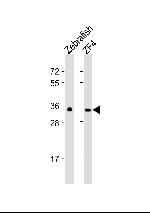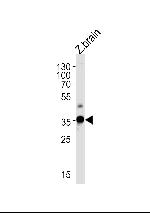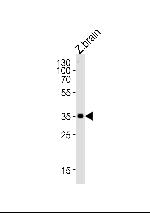Search Thermo Fisher Scientific
FIGURE: 1 / 3
GNB1 Antibody (PA5-72642) in WB



Product Details
PA5-72642
Species Reactivity
Host/Isotype
Class
Type
Immunogen
Conjugate
Form
Purification
Storage buffer
Contains
Storage conditions
Shipping conditions
RRID
Target Information
Vision involves the conversion of light into electrochemical signals that are processed by the retina and subsequently sent to and interpreted by the brain. The process of converting light into an electrochemical signal begins when the membrane-bound protein, rhodopsin, absorbs light within the retina. Photoexcitation of rhodopsin causes the cytoplasmic surface of the protein to become catalytically active. In the active state, rhodopsin activates transducin, a GTP binding protein. Once activated, transducin promotes the hydrolysis of cGMP by phosphodiesterase (PDE). The decrease of intracellular cGMP concentration causes the ion channels within the outer segment of the rod or cone to close, thus causing membrane hyperpolarization and, eventually, signal transmission. Rhodopsin activity is believed to be shut off by phosphorylation followed by binding of the soluble protein, arrestin. Transducin, once activated by rhodopsin, promotes the hydrolysis of cGMP by PDE. The subunit composition of transducin differs between different photoreceptor cells. Rod transducin consists of rod transducin alpha (Tr alpha), T beta, and T gamma. Cone transducin is composed of cone transducin alpha (Tc alpha), T beta and T gamma. Differential transducin subunit composition of transducin is believed to be responsible for the different light sensitivities between photoreceptive cells.
For Research Use Only. Not for use in diagnostic procedures. Not for resale without express authorization.
References (0)
Bioinformatics
Protein Aliases: gbb1; guanine nucleotide binding protein (G protein), beta polypeptide 1; Guanine nucleotide-binding protein G(I)/G(S)/G(T) subunit beta-1; T beta; Transducin beta chain 1
Gene Aliases: gnb1; wu:fb50b09; wu:fj94h04
UniProt ID: (Zebrafish) Q6PH57
Entrez Gene ID: (Zebrafish) 322104

Performance Guarantee
If an Invitrogen™ antibody doesn't perform as described on our website or datasheet,we'll replace the product at no cost to you, or provide you with a credit for a future purchase.*
Learn more
We're here to help
Get expert recommendations for common problems or connect directly with an on staff expert for technical assistance related to applications, equipment and general product use.
Contact tech support
